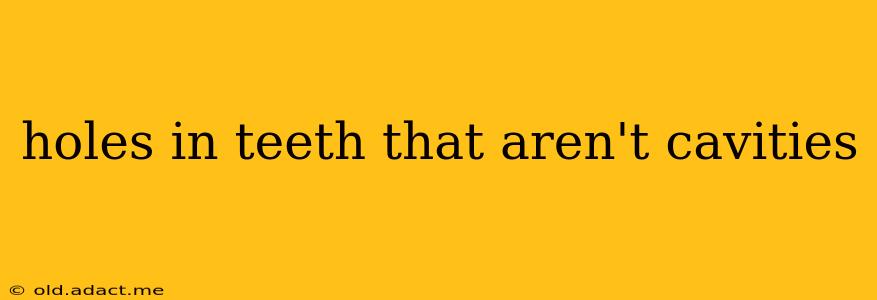Discovering a hole in your tooth can be alarming, immediately bringing to mind the dreaded cavity. However, not all holes in teeth are caused by tooth decay. Several other factors can lead to tooth imperfections that resemble cavities but have different underlying causes and require different treatments. This article will explore these various possibilities, helping you understand what might be causing the hole in your tooth and what steps you should take.
What Causes Holes in Teeth Besides Cavities?
Several conditions can cause holes or pitting in teeth that aren't related to dental caries (cavities). These include:
1. Enamel Hypoplasia: This condition occurs during tooth development, resulting in thin or poorly formed enamel. This weaker enamel is more susceptible to wear and tear, leading to small pits or holes on the tooth surface. Enamel hypoplasia can be caused by various factors, including genetic conditions, illnesses during childhood (such as high fever), nutritional deficiencies, or trauma to the developing teeth.
2. Erosion: Unlike cavities, which are caused by bacteria, erosion is the gradual loss of tooth structure due to acids. These acids can come from various sources, such as acidic foods and drinks (citrus fruits, soda), gastroesophageal reflux disease (GERD), or even certain medications. Erosion can lead to noticeable pitting or holes in the teeth, especially on the biting surfaces.
3. Attrition: This refers to the wearing away of tooth structure due to tooth-to-tooth contact. This is a natural process that accelerates with age, grinding habits (bruxism), or the use of abrasive toothpastes. Attrition can create noticeable wear on the biting surfaces of the teeth, appearing as shallow holes or flattening.
4. Abfraction: This is a type of tooth wear that affects the areas just below the gum line. It's thought to be caused by repeated stress and flexing of the teeth, leading to microfractures and loss of tooth structure. Abfraction can create V-shaped notches or wedge-shaped defects near the gum line.
5. Tooth Fracture: A physical impact or injury to the tooth can cause a chip or fracture, resulting in a hole. This can range from a small chip to a significant fracture requiring extensive dental treatment.
How Can I Tell If It's a Cavity or Something Else?
Distinguishing between a cavity and other causes of holes in teeth can be challenging and requires a professional examination. However, some indicators might point towards a particular cause:
- Location: Cavities often start in the pits and fissures of the chewing surfaces or between teeth. Erosion tends to affect the smooth surfaces of the teeth. Abfraction usually appears near the gum line.
- Appearance: Cavities are typically darker in color and may have a soft or sticky texture. Erosion and attrition might appear smoother and less irregular.
- Sensitivity: Cavities are often sensitive to hot, cold, sweet, or sour stimuli. Erosion and attrition might also cause sensitivity, but the extent and nature of the sensitivity might differ.
What are the Treatment Options for Holes in Teeth That Aren't Cavities?
The treatment for a hole in a tooth depends entirely on its cause:
- Enamel Hypoplasia: Treatment might focus on cosmetic improvements, such as bonding or veneers, to improve the appearance of the affected teeth.
- Erosion: Treatment involves reducing acid exposure (diet changes, medication adjustments) and possibly using fluoride treatments to strengthen the enamel. Restorations might be needed in severe cases.
- Attrition: Treatment options include dental guards (night guards) to protect teeth from grinding, adjustments to bite, and possibly dental restorations to improve aesthetics or function.
- Abfraction: Treatment often involves bonding or restorations to repair the damaged areas.
- Tooth Fracture: Treatment varies widely depending on the severity of the fracture, ranging from bonding to crowns or root canals.
Should I See a Dentist If I Have a Hole in My Tooth?
Yes, absolutely. Even if you suspect the hole isn't a cavity, a professional dental examination is crucial to determine the underlying cause and receive appropriate treatment. Early diagnosis and intervention are essential to prevent further damage and preserve your oral health. Delaying treatment can lead to increased sensitivity, further tooth loss, and more extensive—and potentially costly—dental work.
How Often Should I Visit the Dentist for Checkups?
Regular dental checkups are crucial for maintaining good oral health and catching potential problems like cavities or other issues early on. Most dentists recommend visiting for checkups and cleanings at least twice a year, or more frequently depending on your individual needs.
Can I Prevent Holes in My Teeth?
While some causes of tooth holes are unavoidable, you can take steps to minimize your risk:
- Maintain good oral hygiene: Brush and floss regularly.
- Limit acidic foods and drinks: Consume them in moderation.
- Use a fluoride toothpaste: Fluoride strengthens enamel.
- Wear a mouthguard if you grind your teeth: This protects teeth from attrition.
- Visit your dentist regularly: Early detection is key.
Remember, this information is for educational purposes only and does not constitute medical advice. Always consult with a qualified dental professional for diagnosis and treatment of any dental concerns.
